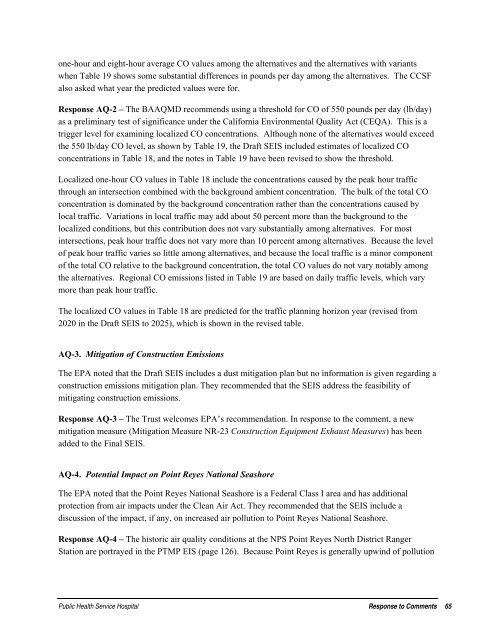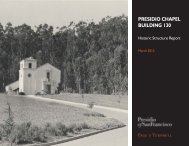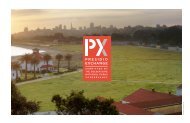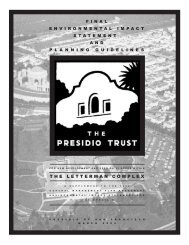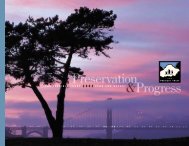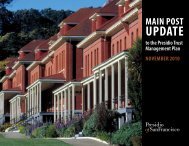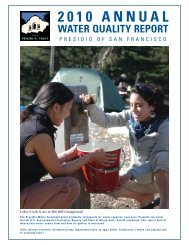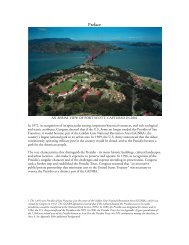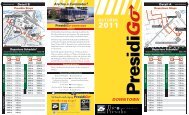Response to Comments - Presidio Trust
Response to Comments - Presidio Trust
Response to Comments - Presidio Trust
You also want an ePaper? Increase the reach of your titles
YUMPU automatically turns print PDFs into web optimized ePapers that Google loves.
one-hour and eight-hour average CO values among the alternatives and the alternatives with variantswhen Table 19 shows some substantial differences in pounds per day among the alternatives. The CCSFalso asked what year the predicted values were for.<strong>Response</strong> AQ-2 – The BAAQMD recommends using a threshold for CO of 550 pounds per day (lb/day)as a preliminary test of significance under the California Environmental Quality Act (CEQA). This is atrigger level for examining localized CO concentrations. Although none of the alternatives would exceedthe 550 lb/day CO level, as shown by Table 19, the Draft SEIS included estimates of localized COconcentrations in Table 18, and the notes in Table 19 have been revised <strong>to</strong> show the threshold.Localized one-hour CO values in Table 18 include the concentrations caused by the peak hour trafficthrough an intersection combined with the background ambient concentration. The bulk of the <strong>to</strong>tal COconcentration is dominated by the background concentration rather than the concentrations caused bylocal traffic. Variations in local traffic may add about 50 percent more than the background <strong>to</strong> thelocalized conditions, but this contribution does not vary substantially among alternatives. For mostintersections, peak hour traffic does not vary more than 10 percent among alternatives. Because the levelof peak hour traffic varies so little among alternatives, and because the local traffic is a minor componen<strong>to</strong>f the <strong>to</strong>tal CO relative <strong>to</strong> the background concentration, the <strong>to</strong>tal CO values do not vary notably amongthe alternatives. Regional CO emissions listed in Table 19 are based on daily traffic levels, which varymore than peak hour traffic.The localized CO values in Table 18 are predicted for the traffic planning horizon year (revised from2020 in the Draft SEIS <strong>to</strong> 2025), which is shown in the revised table.AQ-3. Mitigation of Construction EmissionsThe EPA noted that the Draft SEIS includes a dust mitigation plan but no information is given regarding aconstruction emissions mitigation plan. They recommended that the SEIS address the feasibility ofmitigating construction emissions.<strong>Response</strong> AQ-3 – The <strong>Trust</strong> welcomes EPA’s recommendation. In response <strong>to</strong> the comment, a newmitigation measure (Mitigation Measure NR-23 Construction Equipment Exhaust Measures) has beenadded <strong>to</strong> the Final SEIS.AQ-4. Potential Impact on Point Reyes National SeashoreThe EPA noted that the Point Reyes National Seashore is a Federal Class I area and has additionalprotection from air impacts under the Clean Air Act. They recommended that the SEIS include adiscussion of the impact, if any, on increased air pollution <strong>to</strong> Point Reyes National Seashore.<strong>Response</strong> AQ-4 – The his<strong>to</strong>ric air quality conditions at the NPS Point Reyes North District RangerStation are portrayed in the PTMP EIS (page 126). Because Point Reyes is generally upwind of pollutionPublic Health Service Hospital <strong>Response</strong> <strong>to</strong> <strong>Comments</strong> 65


